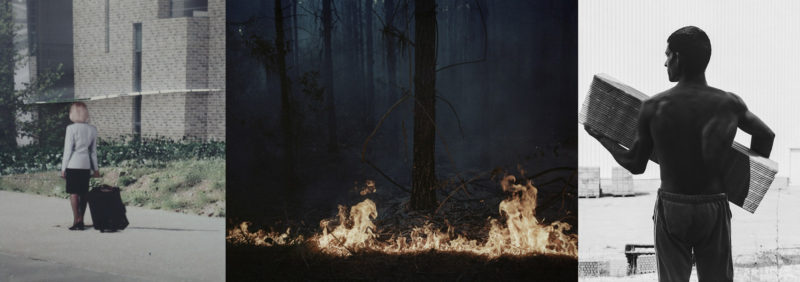Michael Schmidt‘s Ein-Heit (U-Ni-Ty) and Peter Puklus‘ The Epic Love Story of a Warrior share many characteristics. In both books, its makers attempt to tell history using only photographs. Their narrative strategies are elliptical and, one must add, at times oblique, requiring attentive and patient viewers. The books are unlikely to reach larger audiences beyond the world of art photography, given they require a high degree of visual literacy. They are expressions of photographs as art in its most ambitious form.
Ein-Heit relies on a combination of imagery that includes Schmidt’s own straight photographs as much as appropriated ones that were rephotographed from publications, usually with their mass-reproduction artifacts clearly visible (note that Schmidt did this over a decade before using archival imagery in photobook form became all the rage). Schmidt’s straight photograph comprise portraits, city- and landscapes, plus fairly tightly cropped photographs of interiors. The photographs are all presented in what we could call Schmidt vision, that form of black and white where the infinity of very heavy greys so powerfully communicates the sense of morbid gloom that was prevalent in West Berlin before the wall came down (in many places, it’s still there).
Puklus’ book uses different photographic strategies. To begin with, he mixes b/w and colour, with the colours being slightly desaturated and on the cooler side. Unlike in Schmidt’s case, a very large number of photographs were produced in the studio, whether they’re the various nudes (most, but not all of them, showing female bodies) or bricolage style constructions of very basic materials. In addition, there are also interiors, quite a few cityscapes, plus a smaller number of landscapes.
Both Ein-Heit and Love Story rely on insider and historical knowledge, without making a lack thereof too frustrating an experience for a viewer not familiar with what s/he is looking at. A viewer might know that the photograph on page 161 of Ein-Heit looks like it was photographed of the artist’s identity card. S/he might recognize Puklus in a striped shirt somewhere near the end of his book, or as the model for one of the busts that is depicted in various studio photographs. Beyond those pictures, a historically literate viewer might recognize, for example, West Germany’s first Chancellor in one of Schmidt’s rephotographed archival images, or s/he might be familiar enough with cultural imagery to realize Puklus re-created some of it in his studio, whether with a model or otherwise.
These are the kinds of book that typically have me receive somewhat exasperated emails from photographers for whom this all is a bit too complex. To a degree, I sympathize with their conundrum. These are difficult books, and some of us might not have the patience or time or even knowledge to deal with them. I get that. But there is only so much patience I have with this kind of complaint, given that photobooks can be more complex than the popular one-liner books. For what it’s worth, the diet of photobooks I live on does not merely consist of these elliptical ones. But I also love the challenges they pose very much.
Of course, this is not to say that any person’s personal opinion is more valid than everybody else’s (regardless of the size of the sympathetic crowd it comes with). My point merely is that books like Ein-Heit and Love Story ultimately are accessible, provided a viewer is willing and able to do a bit more work. Look at any form of art, and you will find similar examples. To demand of each and every photobook that it be easily and readily accessible would vastly diminish what the medium has to offer.
Coming back to Ein-Heit and Love Story, there is something else that unites them, namely their attempt to deal with history on a large scale. While Schmidt tackled the newly re-united Germany, its past and identity, Puklus trains his eye on something even larger, Europe’s history, the roughly 100 years starting in 1914. Attempts such as these obviously can only be called highly ambitious, and both artists manage to pull theirs off.
It would seem that talking about history only with pictures is a problematic endeavour. It is. But this only is true if you think of history as a set of fixed events that happen one after the other. Of course, there are events that can be used as such tracers. But on larger scales, they tend not to conform to a sense of linearity so easily. In literature, the likes of Vasily Grossman and William Vollmann have explored this idea with Life and Fate and Europe Central
, respectively. These books tell Europe’s history (World War 2) using literary means, and they employ a variety of tricks unavailable to historians. There clearly is the underlying basic linearity of events. Yet at the same time, the two writers focus on the lives of a larger variety of characters, fictional or real (in Grossman’s case, the main character is infused with the author’s biography; in Vollmann’s case, real people are given another fictional life, which for sure is going to confound some readers). In both cases, history powerfully unfolds as a series of personal human dramas.
A different approach was used by Walter Kempowski in Swansong 1945: A Collective Diary of the Last Days of the Third Reich, which “simply” is a collection of actual writings by a large variety of people over the course of the Nazi Germany’s last four days. Kempowski acts like a somewhat disinterested historian who will present the writing of figures you’d find in your history book alongside a vast number of writing you would never hear of: letters, diary entries, and more. Just like in the case of Life and Fate and Europe Central, the result is overwhelming in the best possible sense. Do yourself a favour, and buy at least one of these books to see what I mean.
How could any of this done with photographs? Because of photography’s somewhat complicated relationship with reality, I think the Vollmannian model, the mix of the factual with the imagined, comes closest to what can be done. Straight photographs usually are descriptions of something real. At the same time, there are all those fictional elements that come in through the photographer’s decision process and through her or him making the audience see and believe in certain things. This is, I believe, what makes photography so infuriating when it’s used “shamelessly”: just like in Vollmann’s case, parts of the audience will resist seeing facts and fiction getting mixed. Dmitry Shostakovich, the famed composer, stuttering his way through a musical piece turning into sex — that’s just a step too far for many (you want to read this in Europe Central — as much as I enjoy Shostakovich’s music, to see him being given this all-too human life adds so much humanity to an otherwise unknowable human being).
This would be the model for Schmidt and especially Puklus (my own having met both artists doesn’t quite make me see the German photographer in a Vollmanian sense). As a viewer, you will have to be able to move beyond photography’s simple descriptiveness and allow for it to allude to larger things, to talk of them, or to simply parody them. Love Story is filled with all of that. There is a basic structure, provided by chapter breaks (given titles such as “The beginning of hope. 1918-1939”). Beyond that, though, you will have to pick up on what the pictures provide. As I noted above, you will be familiar with some imagery, but not necessarily with all of it.
Puklus is too smart a photographer to merely create copies or parodies of well-known imagery. His photograph of a man giving the fascist salute, for example, shows the model having an erection, clearly pointing at a larger truth about fascism (which should be pretty obvious to anyone who has ever seen Leni Riefenstahl photographs). Most of the photographs of models present them in the nude, often, but not always, striking poses one would be familiar with from statues. But the absence of clothes also removes the specificity a clothed portrait would have: these models are human beings first, standing in for a multitude of other people.
I feel some of the devices used in the book were overused, though. There’s a poem included in the book, presented as one character per page (in lieu of page numbers). And Puklus makes use of multiple versions of the same photograph, for example as in the views one would have walking around a statue. This works for a while, but a bit less of it might have made for a stronger book. Repetition is a very good device for photography, but it needs to be used carefully (Schmidt does so in Ein-Heit, but a lot more sparingly than Puklus). Finally, Love Story opens from the back. I suppose you could also look at it like a Western style book, and then you’d walk back in time. I’m torn about this as well.
These quibbles aside, while I felt mostly underwhelmed by the world of photobooks in 2016 (a few very notable exceptions aside), this year did produce Love Story, a book that, no doubt, I will have to come back to frequently over the next few months.
We are witnessing in our world right now that progress isn’t linear. Steps forward are followed by steps back. It’s hard not to despair over the ascent of neo-fascism not just in countries like Russia, but also in established Western democracies (sure, call it “authoritarianism” if you can’t stomach calling it what it is). We’ll have to remind ourselves that once established, democracy needs to be defended. Where the defenses come down, the neo-fascists win.
History in general can help us re-learn our lessons, to see what is at stake. This is true regardless of whether we read “proper” history books or novels such as Grossman’s or Vollmann’s. And it is true if we look at photobooks such as Ein-Heit or The Epic Love Story of a Warrior. This is why these books matter greatly: they attempt to speak of the kinds of larger truths that we’re in somewhat desperate need of these days.
The Epic Love Story of a Warrior; photographs by Peter Puklus; 468 pages; SPBH Editions; 2016
Rating: Photography 5.0, Book Concept 5.0, Edit 2.0, Production 4.5 – Overall 4.4

















